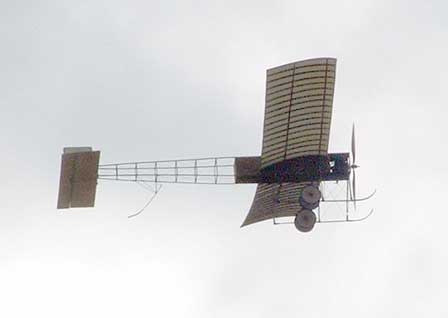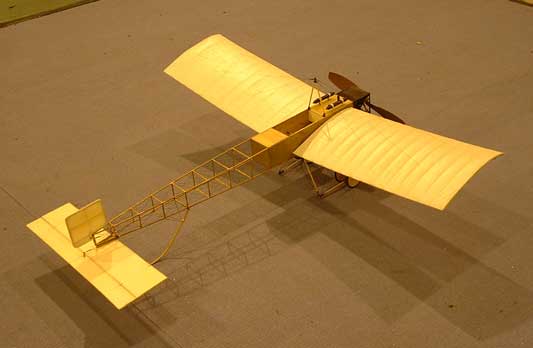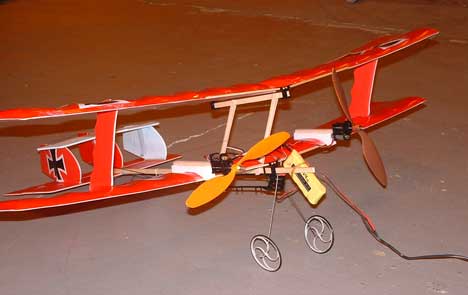

Just to bring you up to date with my Sopwith "Bee"
(Sloping Off June 2003), the plan was published in the October
issue of Flying Scale Models, and at the end of the article I
asked if anyone had any more information. This is usually the
key to a stony silence, but this time, Steve from Richmond on
Thames sent me some new photos and a paragraph or two from his
book collection. It turned out that the wingspan was 16' 3",
i.e. two feet less than I thought and the length 14' 3",
a foot less than my drawing. I drew up various alternatives,
we corresponded and he turned up a photo from Flight magazine
1951 which shed even more confusion on the subject, as I just
could not resolve some of the anomalies between the various photos
and dimensions. I got to thinking that there must have been two
Sopwith Bees, and one of them was kept a secret! Finally I decided
that the measurers had got it wrong in 1917, and although the
span was right, the length was 15' 3", not 14' 3" as
stated in the book. I also heard from Al Backstrom in Texas who
wants the updated plan for a Peanut free flight model. I just
love E-mail! Anyway, I put the drawing to bed and moved on to
something else...
... which was Sopwith learning to fly in 1912 when he was 22.
Actually, as related in Chapter One of "Sopwith - the Man
and His Aircraft", he visited Brooklands during October and
flew two circuits as a passenger in a Henry Farman biplane: shortly
afterwards he bought a Howard-Wright monoplane for £630
and on the 22nd flew himself into a crash (caused by over controlling).
Undeterred he had the machine repaired and flew his first controlled
solo flight on 4th November. There are three pictures of him
in this spindly-looking monoplane at Brooklands, two on the ground
and one, a wonderful photograph, of the plane in the air with
him leaning forward but relaxed, a natural pilot. The eponymous
Mr Howard-Wright was no relation to the more famous brothers,
but an engineer and designer living in London close to Sopwith.
He also made a biplane in which Sopwith captured the British
endurance record later in the same year.
The design is typical of its time, with an open fuselage, cambered wings and a heavy engine in a very short nose, with a blizzard of struts and bracing wires. I thought that 1/16th square basswood might give a scale-looking structure for fuselage, wings and undercarriage. The short nose meant that all the RC gear would have to be concentrated very close to the front. A Lithium Ion twin-pack and the lightest GWS hardware weigh over 100 grams, but the 32" span model weighs less than 60 grams, and I did not buy special wood or build particularly lightly.
I got sixteen strips of 1/16th square basswood from Lesro Models (£1.92) and assembled half of them into the fuselage, half of the rest into the undercarriage and the remainder made the leading and trailing edges of the wings. The ribs were two laminations of 1/16th square balsa cut from medium stock sheet (45p) superglued together over an old Bleriot rib outline. It all wobbled alarmingly, but when braced with black thread (free from Wendy's sewing box), covered with Airspan (like Litespan but even more irritating) and assembled, it weighed a little bit over 2oz - and all for less than £3. However, such a delicate structure must be fully braced or it will immediately fold up during its first take-off!
 I took the completed
model to the first Calshot meeting of the season and, after breaking
the CF axle of my little Sopwith Sparrow, was not too confident!
The rudder looked very, very small and the balance point was
simply as things turned out, rather than being deliberately planned.
Ah well. I lined it up and announced that I was "just going
to taxi", throttled up and off she went, straight and true.
Just a touch of up and she flew perfectly towards the banked
track at the end of the hangar - and the wall. Obviously time
to see if the rudder would have any effect at all.
I took the completed
model to the first Calshot meeting of the season and, after breaking
the CF axle of my little Sopwith Sparrow, was not too confident!
The rudder looked very, very small and the balance point was
simply as things turned out, rather than being deliberately planned.
Ah well. I lined it up and announced that I was "just going
to taxi", throttled up and off she went, straight and true.
Just a touch of up and she flew perfectly towards the banked
track at the end of the hangar - and the wall. Obviously time
to see if the rudder would have any effect at all.
I needn't have worried, she turned perfectly and flew majestically and very slowly round the circuit at half throttle. Figure 8s were no problem and landings were so easy, just throttling back to a tick over and pull up a touch of elevator and she flew herself gently to the floor. I had four or five flights that evening and each was more rewarding as the nerves settled and I could watch and enjoy. I had a lot of support from the Southampton guys who resisted the urge to intercept with IFOs and Sticks, and each flight ended with one of those perfect landings. Definitely a first for me. I haven't yet made a foam pilot, as I'm a bit worried about what it will do to the airflow over the rudder, but the plane simply does not look right without one (the pilot, I mean), so I'm onto it.
Then at Fleming Park I was silly enough to try the limbo competition and slightly damaged a wing, so took the opportunity to build a longer span version (36") to see how slowly it would fly. I need not have bothered, because at Calshot in November I could see no difference between the two versions, although Trevor did point out that if I reduced the rather large washout then perhaps the wing would work properly. And I'm sure it will fly at Oakmead, if those pesky new Butterflies can keep still for a moment!
 |
Mike also sent me these two pictures taken on that first Calshot outing. Whilst one shows the Howard Wright looking most realistic, the other is of a rather more experimental aircraft. |
| Now, what twin engined scale project could he have in mind? Must be a Sopwith, of course! - Ed. |  |